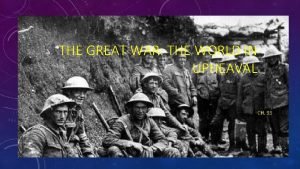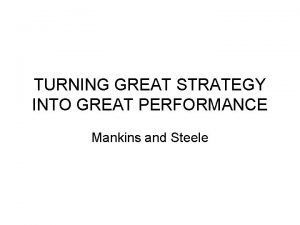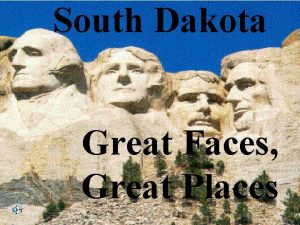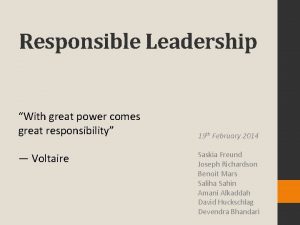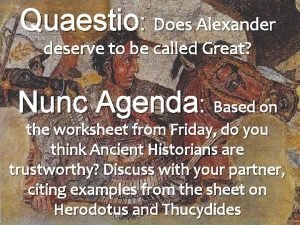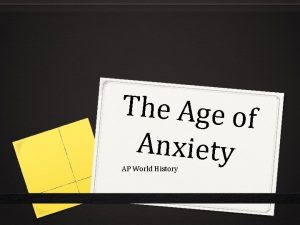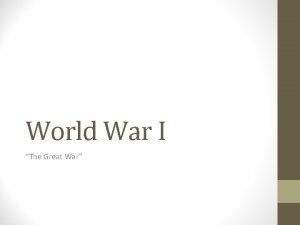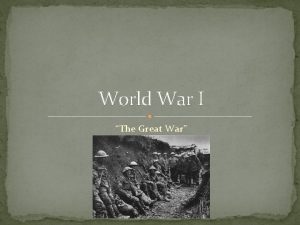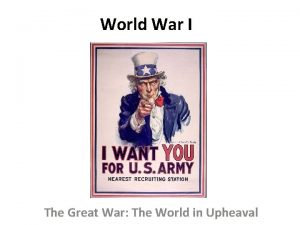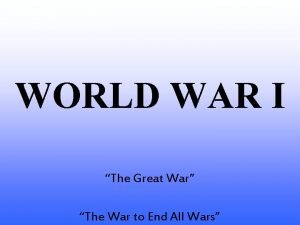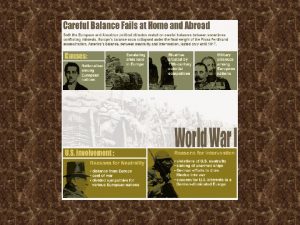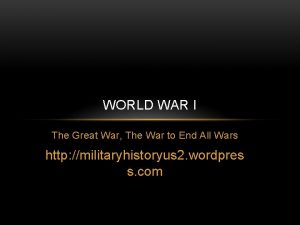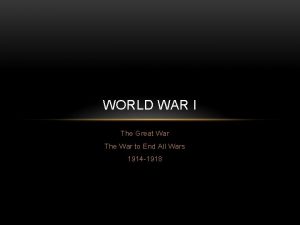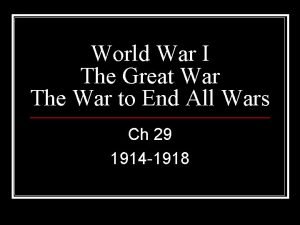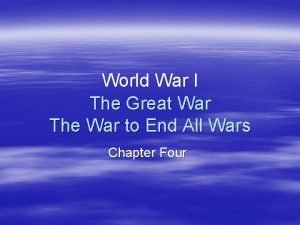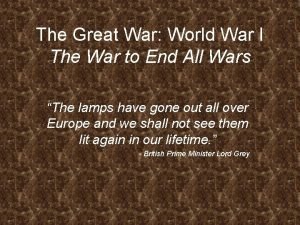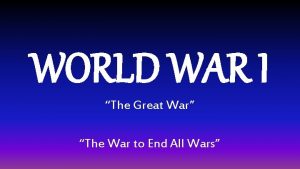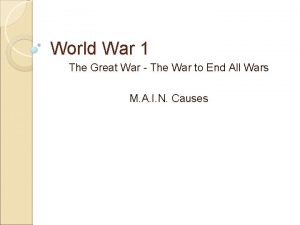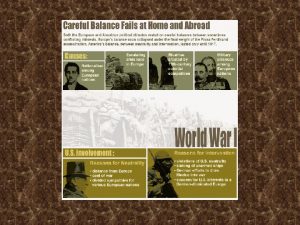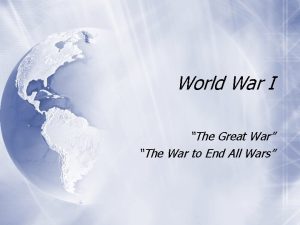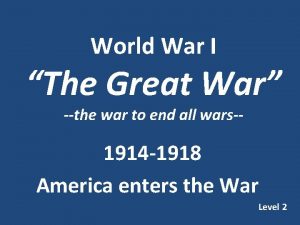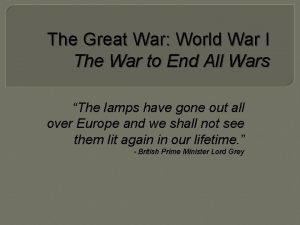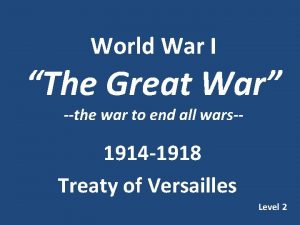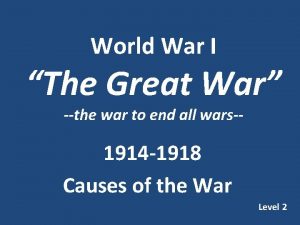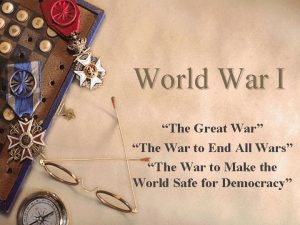World War I The Great War the war





























- Slides: 29

World War I “The Great War” --the war to end all wars-- 1914 -1918 Fighting the War Level 2

Essential Question • How did warfare change in World War I

Millions European Countries Mobilize for War 14 12 10 8 6 4 2 0 Soldiers Mobilized France Germany Russia Britain

The Schlieffen Plan Germany Attacks France Through Belgium August 4, 1914

Two Front War Develops in Europe 1) Eastern Front Germany & Austro-Hungary push deep into Russia then slows 2) Western Front Germany Attacks France through Belgium - Allies stop the German offensive just outside of Paris as the attack bogs down • Trench War – Stalemate (attack-retreat)

Trench Warfare “No Man’s Land”



Major Trench Battles in WWI 1) Battle of Verdun (Feb-July 1916) 1 million men – killed/wounded/missing 2) Battle of the Somme (July-Nov 1916) 60, 000 British Casualties in one day 1 million killed


The Western Front

Fighting Took place in the Colonies too - Africa British Sikh Mountain Gunners Black Soldiers in the German Schutztruppen [German E. Africa]

T. E. Lawrence (of Arabia) & the “Arab Revolt”, 1916 -18

Weapons of War The Great War saw destruction on the field of battle like never before 1) Old-Fashioned Strategies 2) New Technologies

German U-Boats

Allied Ships Sunk by U-Boats

Poison Gas Attacks

The three main types of Poison Gas Chlorine - a greenish, yellow heavier than air gas which in its pure form is an oxidizing agent. This means that it will react in the presence of water to cause a chemical burning effect on organic matter. Phosgene - a colorless, odorless, heavier than air gas formed by heating carbon tetrachloride. It is highly poisonous in that it will preferentially replace oxygen in the cells and quickly causes an oxygen debt within the body, unconsciousness and death. Mustard gas - gas with a distinctive mustard smell, it causes blistering and huge sores on any exposed tissue, internal or external.

Gas attack seen from an airplane

Machine Guns shoot thousands of bullets per minute

Barbed Wire

Flamethrowers

Phosphorus Grenade Exploding

Krupp railroad gun “Big Bertha” -named after his wife / hard to locate on rail / could shoot over 60 miles from behind German Lines

British Mark I tank

French Renault Tank

The Zeppelin

The Airplane

The Flying Aces of World War I Eddie Rickenbacher, US Francesco Barraco, It. Willy Coppens de Holthust, Belg. Rene Pauk Fonck, Fr. Eddie “Mick” Mannoch, Br. Manfred von Richtoffen, Ger. The {Red
 The great war: the world in upheaval
The great war: the world in upheaval Turning great strategy into great performance
Turning great strategy into great performance Great faces great places
Great faces great places Egoistic leadership
Egoistic leadership How are great white sharks different from hammerhead sharks
How are great white sharks different from hammerhead sharks Does alexander the great deserve his title
Does alexander the great deserve his title Frederick the great enlightened despot
Frederick the great enlightened despot With great expectations comes great responsibility
With great expectations comes great responsibility A great deal vs a great many
A great deal vs a great many With great power comes great responsibility
With great power comes great responsibility Does alexander deserve to be called the great
Does alexander deserve to be called the great No shadow of turning
No shadow of turning How did the great depression impact the world
How did the great depression impact the world Chinese revolution ap world history
Chinese revolution ap world history Great depression ap world history definition
Great depression ap world history definition Frankenstein chapter 18-19 summary
Frankenstein chapter 18-19 summary Hát kết hợp bộ gõ cơ thể
Hát kết hợp bộ gõ cơ thể Bổ thể
Bổ thể Tỉ lệ cơ thể trẻ em
Tỉ lệ cơ thể trẻ em Gấu đi như thế nào
Gấu đi như thế nào Tư thế worm breton là gì
Tư thế worm breton là gì Chúa yêu trần thế
Chúa yêu trần thế Môn thể thao bắt đầu bằng chữ đua
Môn thể thao bắt đầu bằng chữ đua Thế nào là hệ số cao nhất
Thế nào là hệ số cao nhất Các châu lục và đại dương trên thế giới
Các châu lục và đại dương trên thế giới Công thức tính độ biến thiên đông lượng
Công thức tính độ biến thiên đông lượng Trời xanh đây là của chúng ta thể thơ
Trời xanh đây là của chúng ta thể thơ Cách giải mật thư tọa độ
Cách giải mật thư tọa độ Phép trừ bù
Phép trừ bù
